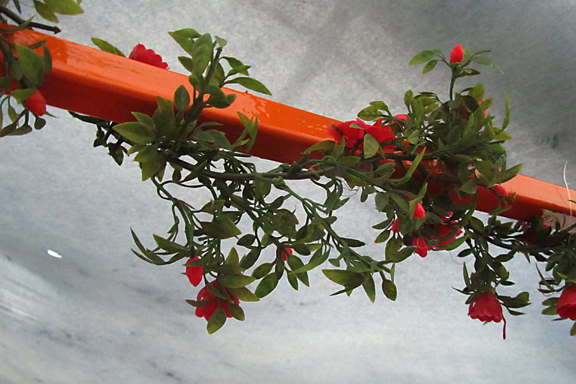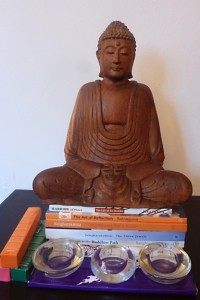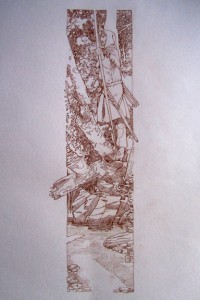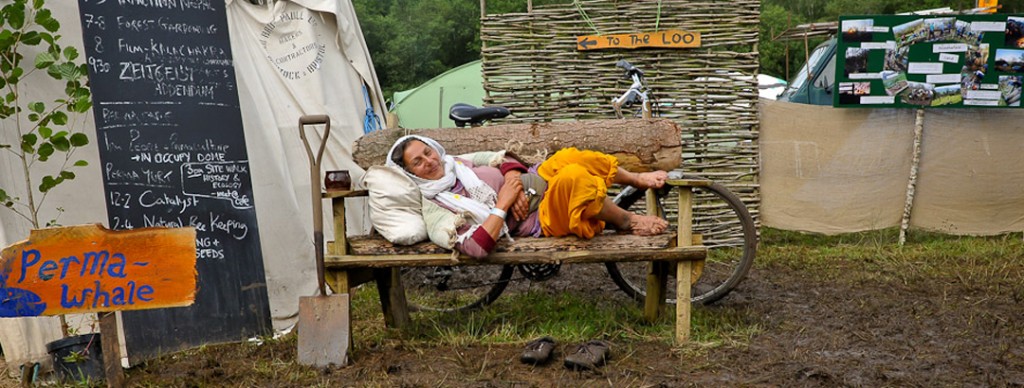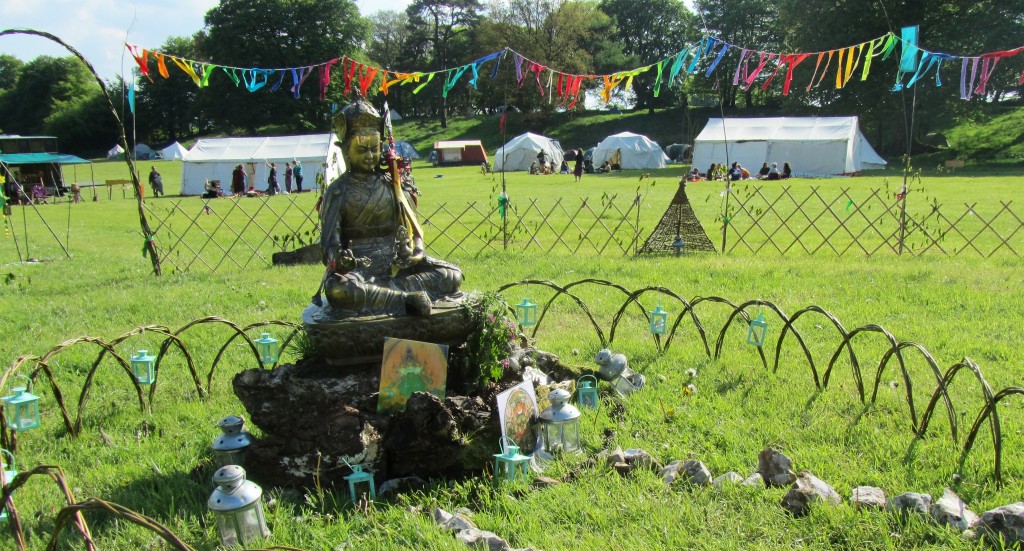Worthy Farm is a town-sized Cinderella whose glamour does indeed start to slip on the stroke of midnight. For a few nights she’s an edgy fairytale princess, but in the wee small hours of Monday morning, the last acts barely having left the main stages, the magic is obviously wearing thin. Within twelve more hours she’s obviously just an otherwise innocuous Somerset dairy farm, a bit worse for the wear and now with few extra chores to do.
At Festival end I’m always left with a set of multi-hued feelings: shades of disappointment for experience I’ve missed out on (I never did get to Hell in Shangri-la); a flush of loss over adventures past (I successfully conspired to meet two friends in the sardine-compressed Pyramid Stage field for The Rolling Stones); not a little relief in being forced to let go of the anxiety that one is missing out on something spectacular, somewhere else on site, at all times of the day and night.
A true Glastonbury veteran is aware that it’s a spectacle that one can never truly, completely consume. Even if one wasn’t working (we do one six-hour shift per day in the Buddhafield Café), one could never investigate every nook or cranny, visit every themed dance space, try every craft workshop, watch every cabaret or circus act, see all the bands … or even sample every cafe, for that matter.
I started writing this on the Buddhafield Festival site, which we rolled onto directly from Pilton (the village that actually homes the Glastonbury Festival). Ostensibly a pole away from the end of a festival spectrum that includes The Rolling Stones, both events actually share a common heritage. (For a time Buddhafield even rented a field from Michael Eavis in its early days over at Shepton Mallet.) But even only a day after we left, it’s a bit difficult to believe that the absurdly demanding world of Glasto really existed. I was sat in the private, core-crew only camping space I dubbed “The Squirrels” (a wood well at the back of our site), sitting surrounded by a carpet of leaves and twigs, enjoying the still, cool air, listening to a stream chattering away to the dusk and sketching out this post on my smartphone. Fighting off the rather insistent midges was only the dimmest echo of the seagulls that were even then circling for tit-bits to scavenge from amongst the detritus in those Pilton fields.
Just like Glastonbury, people wax lyrical about the early days of Buddhafield. There were in fact many incredible things that came about as a result of our innocence and naïveté, but one can’t remain artificially innocent: the wilful blindness to learning from experience slowly turns toxic in the face of change. There have been ongoing difficulties at a management level in Buddhafield as we’ve skidded to a rather bruised end of a natural cycle in our collective’s life. We’re trying to rediscover who we are and what we’re about. But ironically, on the ground, it’s been a very successful team experience for me so far this year.
At Glastonbury in the Buddhafield Café, I had the pleasure of working with a shift of twelve people who’ve been capable, conscientious and harmonious. This is worth remarking on when working in an environment like Glastonbury, which can be quite so physically and emotionally demanding. Even if one isn’t a party animal (and some of us are well up for seeing a couple of dawns in), nothing is simple: one has to balance out a strategy for actually getting to a loo, even before the hygiene situation prods ones boundaries.
In this context, a personal fulcrum of inspiration off of which to hinge Dharma practice is essential. For me it’s cultivating the quality of equanimity, the value of which is probably best highlighted by temporarily living and working in such an intense environment. Upeksha (Pali: upekkha) is the word we usually translate as “equanimity”. It’s the fourth of the Brahma Viharas family of meditation practices, all of which revolve around dimensions of metta (loving-kindness).
Sometimes I like to think of equanimity as being rather like a perfectly reflective ball sat on a flat plane. regardless of the forces exerted on it, the ball remains at rest, mirroring the demands on its attention, but not commanded by them. it also remains a sphere, not pressured out of shape and therefore into distorted reflection. I think a non-equanimous mind is often very distorted: it perceives the world rather like a hall of mirrors, where it moves from a stretched, to a squashed, to a twisted perception without pause or much awareness.
This metaphor is useful in a context where attractive stimulus is so pervasive, especially for those of us with a “butterfly mind”, alighting only briefly on the next in an arbitrary series of experiences, never resting long enough to fully engage. An equanimous mind is paradoxically both active, because it’s flexible and creative, but also at rest, because it’s not grasping or hungry. It’s a mind that is a completely engaged one, moving in the flow and rhythm of full awareness rather than a spastic staccato.
This implies that upeksha isn’t the aloof state that the English translation usually connotes. Because its completely receptive and non-judgemental, maintaining equanimity is a very broad and solid base from which to engage with the world.
If we consider it in the light of working in the Buddhafield Café, we can say that an equanimous state implies being aware of the whole length of the queue at the counter, pacing every interaction accordingly, whilst at the same time giving each customer the fullest attention. The opposite mental state would probably be anxiety, where one is more caught up with imputing frustrations at the back of the queue than offering the person at the front an efficient service.
Anxiety is rather like running with a leaky bucket. It doesn’t actually address the problem and likely as not makes spillage worse. Ones attention is placed on the future and on conditions over which one may have little or no control. Anxiety is an example of awareness – the reflective ball of my earlier metaphor – twisted out of shape, thus distorting ones response to the flow of conditions.
In equanimity we’re actually always at the Ball because we’re alive to the wonder that’s going on around us all the time. We’re not grasping after adventure, novelty, distraction or amusement. We’re not pushing away the unpleasant, unwanted, pedestrian or routine. Equanimity is in fact our glass slipper.

 The Camp will feature a workshop programme of green crafts, offering the chance to make something beautiful with our own hands and learn new but traditional skills; social change workshops and ecology talks, helping us to face difficult truths about ourselves and the world; Meditation, Rituals and Dharma talks giving us the spiritual context in which to explore those truths and help us grow and change together. We all can become what the world needs now — alive, aware, in touch with the earth, connected.
The Camp will feature a workshop programme of green crafts, offering the chance to make something beautiful with our own hands and learn new but traditional skills; social change workshops and ecology talks, helping us to face difficult truths about ourselves and the world; Meditation, Rituals and Dharma talks giving us the spiritual context in which to explore those truths and help us grow and change together. We all can become what the world needs now — alive, aware, in touch with the earth, connected.
